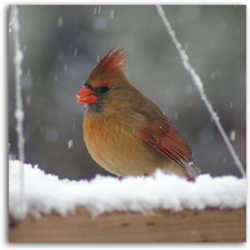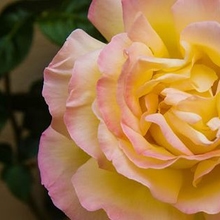| A planted aviary is something anyone can truly appreciate. It shows the love a person has for their birds as well as their utter appreciation for nature. You don't have to spend thousands of dollars to create one, if you're willing to do a little work then you can have a gorgeous oasis for very little money. Remember, I'm cheap so I wouldn't spend tons of money on anything! There is no bird created that wouldn't live longer and be happier if they had access to plants and a near natural setting. If you plan carefully you can use plants these creatures would have access to in their homelands! This is also a great idea to utilize if you're rehabbing various other species (not just birds!). |
 |  |  |
| Picking a site and various other things to consider. |
Basically what you're doing is planning a normal garden. You do need to plan a bit more in depth though, you are going to be planting things your animals can utilize. Some plants can kill birds... Do some research to figure out what plants to avoid. Choose an area that has no trees to fall into the enclosure. Limbs can poke through a cage and allow your birds to escape, or predators to enter. You'll provide shade with your plantings. Instead of watering your birds everyday, provide them with a well cycled pond with plenty of shallow areas to drink from. The plants you add help break up open spaces so various birds can set up their own territories. This will resolve a lot of issues with aggression, stress that causes feather plucking along with many other problems that arise with captive birds in tiny cages. Birds need sunlight or they can die but make sure they have access to plenty of shade as well. Fried chicken is only good at a picnic, and most assuredly not with a $10,000.00 bird. |
 |  |  |
| Getting the ground prepared. |
Completely clear the area you intend to build on. If possible, level it out very well and till it up nice and loose. Rake out any big sticks or anything that will hinder further plans. Use spray chalk to mark off your boundaries and anywhere you'll add gardens/ponds/housing-etc. Rake in fertilizer/compost in the areas you'll have gardens. Build your structure as you would like making sure to create as tight a pen as humanly possible. No snakes or rats should be able to enter. Use the smallest spaced fencing/wire/screen you can get. Raccoons will literally pull a bird through anything they can reach their nimble hands through! I lost a pair of beautiful doves like this once. Tamp the ground down all around the edges of the aviary. Now is the time to add fence on/under the ground. This helps to keep rodents and other predators from digging into the cage. You may want to pour a concrete foundation and then pile your soil on top of that. Just try and think like a predator while preparing the site. |
|
| |
|
| |
| Make sure to include a catch gate in your plans. It's as simple as a small room built connected to the aviary door. This allows you to enter, close the door and then open the main door safely. If a bird flies out, it is caught in a cage and not flying free in your yard! After you get the area cleared and your enclosure built it's time for the fun stuff. Though you are building to mainly please your birds, you want to enjoy this creation just as much as them. This is your time to sit back and really figure on what you want. Are you looking for Greek ruins? Or maybe a lost paradise complete with hidden nooks and crannies? I'd go for a mix of many mysterious things. Don't feel you have to hold back on decorating. Add pillars and caves and various sized pools and ponds. Really let your imagination run wild! If you're keeping various species try making different areas (regions) for each one. Desert for the desert lovers, tropical islands for those that like that. This could be a really neat project to see how each species reacts to the different landscapes. Most birds benefit from daily dust and water baths. Make sure to include areas they can roll in clean dust and water. This helps fight parasites and keeps them cool-etc. Cavity nesters would love hollow logs and pillars to make a safe home for their babies. Parrots and Corvids love to exercise their minds, place logs and rocks that you can stuff food into. They will love to search them out! This is true of many species. |
| Feeding the birds. |
| I have honestly never had a bird eat something I planted and die. I'm not saying it doesn't happen but... You decide what's best for your birds. Do a little research and find a balanced diet to plant for your birds. Remember, only seeds really isn't a balanced diet. Birds need protein in order to survive, especially nestlings! Try and let insects live in the aviary, the birds will eat them and excercise their minds trying to catch them. Now, because this is a relatively small area you will probably have to supplement your animals diets. A good thing to feed your birds is called "Egg Food". Here's the recipe I use when rehabbing and keeping birds. I feed this daily.
|
| Egg Food Diet Supplement. |
| *-*3 hard boiled eggs peeled and crumbled finely. (reserve the shells) *-*1/2 cup of egglayers crumbles. (chicken scratch-not corn!) Dry the shells by nuking them or on a low setting in the oven until VERY brittle. Smash this into tiny pieces then mix together all ingredients. It's ready to feed! Can be stored in the fridge for about a week. |
 |
| Some Bird Safe Plants |
-Almond
. | -Nasturtium
. | -Aloe -African Violet -Baby's Tear -Bamboo -Begonia -Bougainvillaea -Chickweed -Christmas Cactus -Cissus (Kangaroo Vine) -Coffee -Coleus -Corn Plant -Crabapple -Dandelion -Donkey Tail -Fern (Asparagus, Bird's Nest, Boston , Maidenhair) -Figs (Creeping, Rubber, Fiddle Leaf, Laurel Leaf, Weeping) -Gardenia -Grape Ivy -Hen and Chickens -Jade Plant -Kalanchoe -Magnolia -Marigolds |
|
You will have to trim your trees and various other plants. You can not under any circumstance let them grow into the aviaries` wire/glass/mesh. It will eventually poke through and cause holes..and devastation. The aviary probably won't have enough bird poo to fertilize the plants so you'll have to make sure to add plenty of good compost as often as needed. Unlike your regular flower gardens you need to let several of the plants in the aviary go to seed. The birds will eat the seeds. You can always plant more than one of each plant and keep the others trimmed nice and neat. If you have opted to have a solid roof over the aviary you will need to water the plants as well. Just treat them like a garden you let go to seed. In order to be the most lazy bird keeper I suggest planting a lot of drought tolerant plants. |
 |
| Creating and area for insects and other trace elements. |
Make sure to include fallen/rotting logs in your plans. Many grubs live in and under rotting wood. Grubs are baby beetles so keep that in mind when stocking your aviary with adults. Keep in mind also that some are destructive to agriculture, flowers and grasses/lawns. You can raise your own Drosophila (vinegar flies) to feed your birds, as well as maggots and roaches. Even parrots will take some bugs to supplement their diets. Butterflies make a beautiful and interesting addition to the aviary, just don't be disappointed when they get eaten! Make sure you plant host plants for their larva. Include an area for your butterflies to get their trace minerals. Sink a dish of clay mixed with a horse lick mineral block in a protected area. Wet this so your butterflies can drink it. Just wet it, don't let it sit in water and drown your butterflies. You ever seen parrots eating clay in the wild? It is a natural way for them to bind poisons in their system so they can pass it without dying. Ever wonder if allowing your birds to have access to the right clay could keep them healthy? It's a possibility, there can be many poisons in the air/water/foods we all take in... You could even build a clay wall and watch them chip away at it, if you wanna go through the trouble. Don't forget too, birds need grit. Supply them with ground oyster shells and coarse sand so they can eat it at will. If you are keeping an ostrich/rhea or emu try for pebbles!
|
| Important! Read this! |
For the best results on your aviary I suggest you build it and wait a season (year) before you stock it. This gives everything a chance to really get settled and allows the plants and insects to multiply and get a firm hold before you add predators. It will take careful planning to get the right balance in size of aviary vs stocking of birds and live food. Unless you keep LARGE birds, do not stock the ponds with bullfrogs. They can and do eat anything (birds included) they can catch. On second thought just don't use them period, even big birds have small babies! Make SURE the species you intend to keep can live together peacefully. Maybe avoid pokey plants with large spines.
|
| Special additions/ideas. | |
Don't forget to include an area for you to sit in, a nice place to sip coffee and enjoy your birds and gardens. Keep some seed or other special treats close at hand to offer goodies to your new or old
|
| Remember these things. |
| *-* Clear your ground very well. *-* Choose useful plants. *-* Don't forget the dust and water baths! *-* Allow various insects to live in the aviary! *-* Plenty of Shade! |
Until we talk again,
Jocie.
Special thanks to, Wikipedia for their free use photos and to the Exotic Bird Hospital inc Rhoda Stevenson, for the plant list!






















